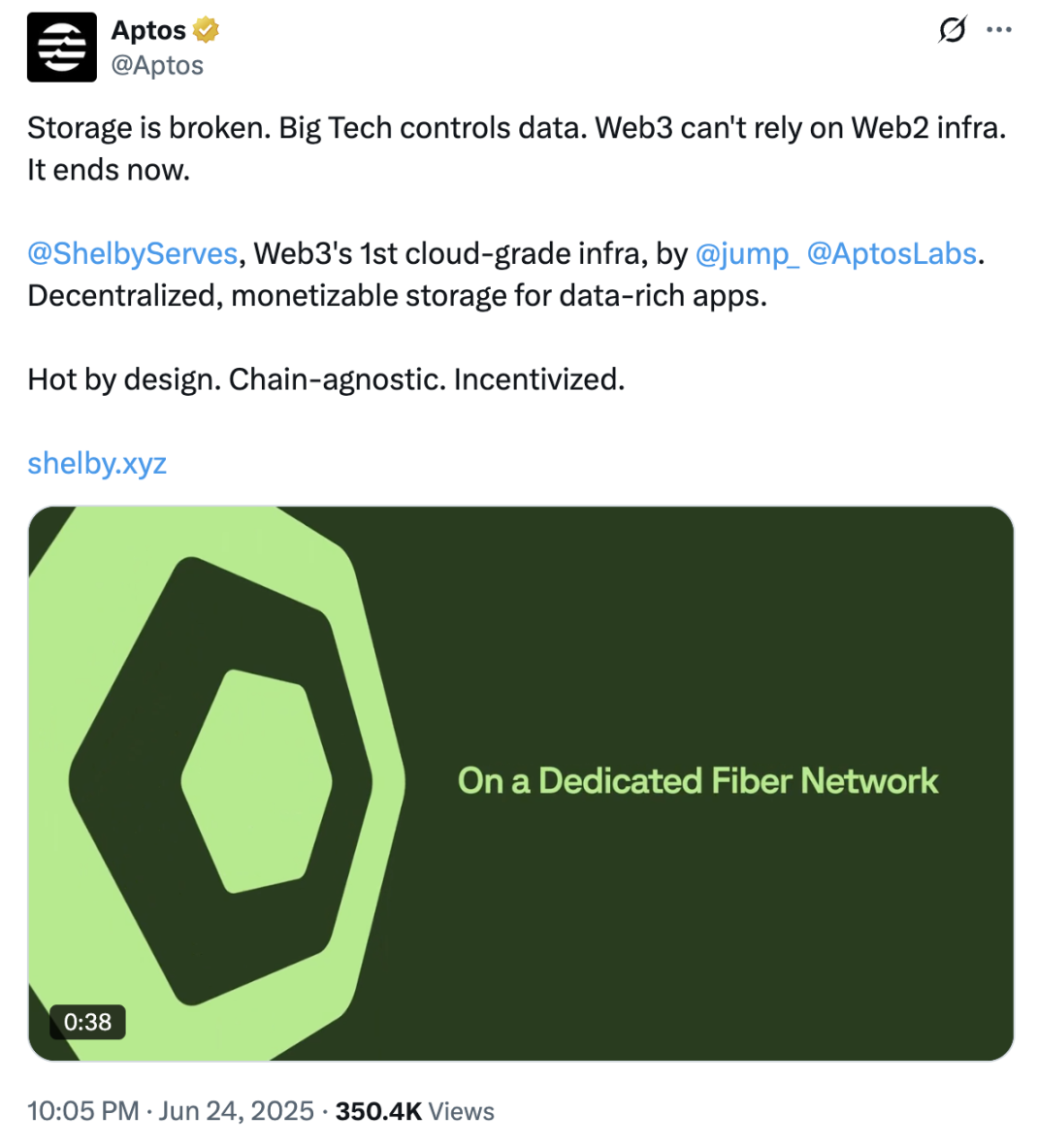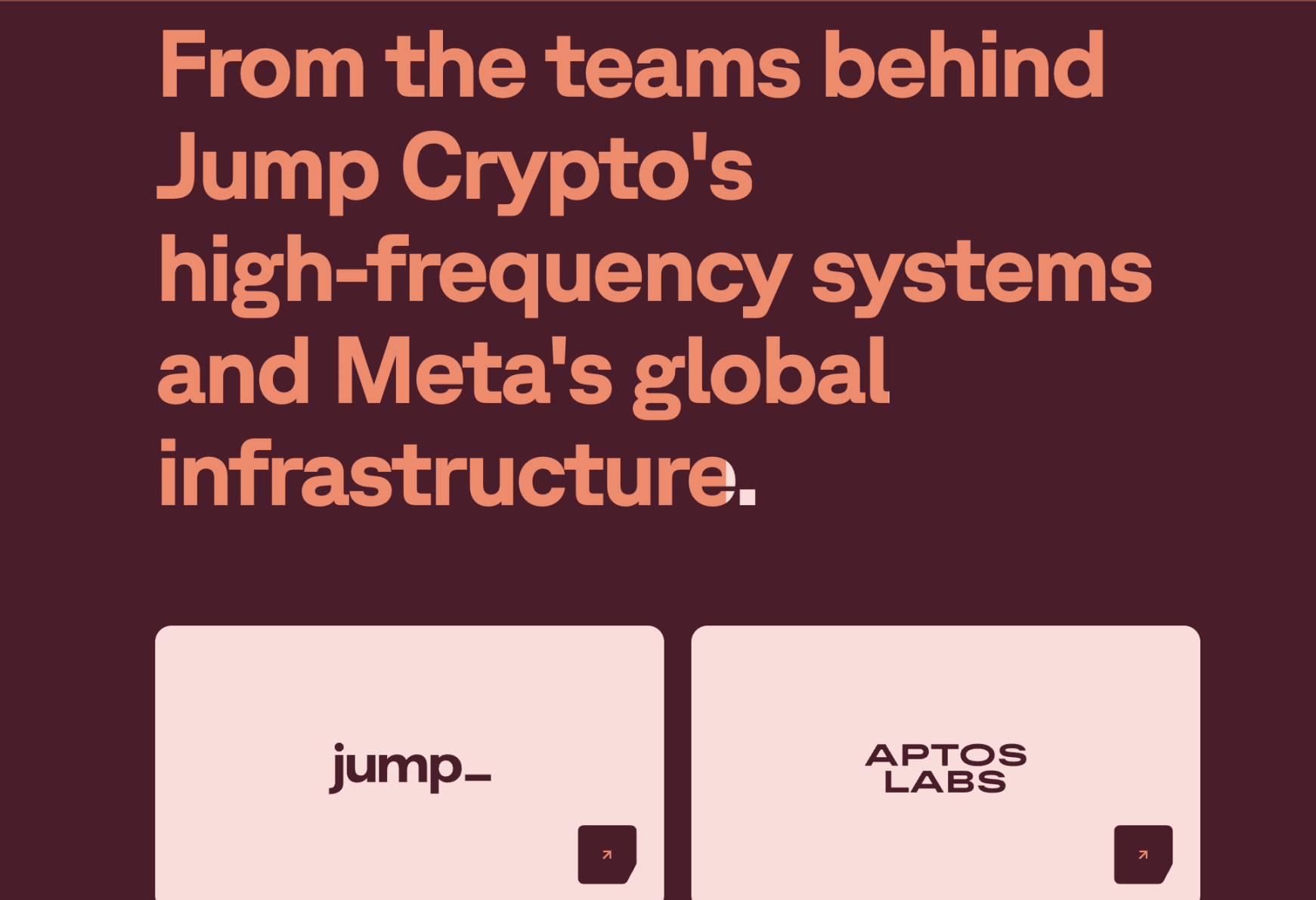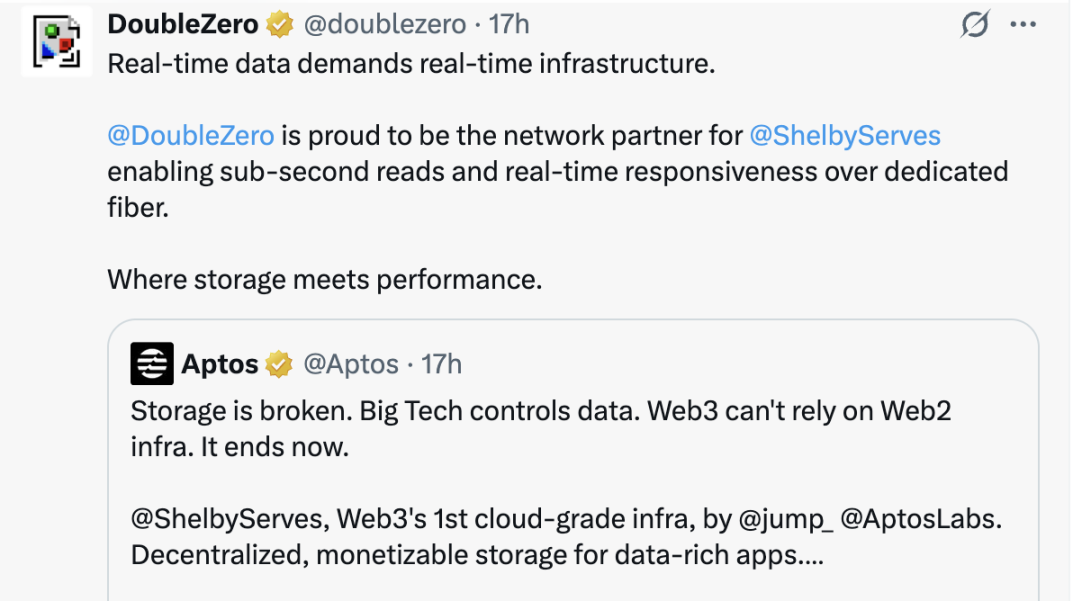Jump collaborates with DoubleZero and other top-tier projects, leading to a 30% surge in APT.
Written by: Alex Liu, Foresight News
On the evening of June 24, Aptos announced a partnership with crypto giant Jump Crypto to launch a new storage protocol called Shelby. This marks Jump Crypto's first major move since returning to the crypto space on June 19. The news triggered a swift market reaction — APT surged by 30%, rising from 4.2 USDT to a peak of 5.13 USDT, marking its best performance in recent times.

Jump Crypto previously invested in Aptos Labs' $150 million Series A funding round in 2022, known for its "gathering" capabilities and engineering prowess. For instance, Jump is a major contributor to Solana's highly anticipated validator client Firedancer. As the first high-profile project since Jump's return, Shelby brings renewed attention to Aptos and creates an "imagination space" for ecological synergy and prosperity.
However, there are doubts. With Sui having launched the storage protocol Walrus first, is Aptos merely copying a competitor's strategy? Let's delve into Shelby.
Shelby, the "Hot Storage Protocol"
From Cold to Hot: A Shift in Web3 Storage Paradigms
In the narrative of Web3 infrastructure, decentralized storage has always been a key topic. However, this field has long been dominated by "cold storage": suitable for storing low-frequency access, long-term data, such as NFT metadata and backups. Typical representatives include Filecoin and Arweave, which emphasize durability and cost optimization but may not be suitable for high-frequency, real-time scenarios.
Shelby is a "hot storage" solution addressing this pain point.
According to the official definition, Shelby is the world's first "cloud-grade infrastructure" in the Web3 space, featuring sub-second read speeds, native incentive mechanisms, and chain-agnostic compatibility. It not only allows data to be stored but also enables data to flow, be usable, and be valued, serving applications with high real-time requirements such as video streaming, AI outputs, dynamic NFTs, and gaming assets.
Currently, Shelby uses Aptos as its preferred settlement layer, leveraging its 600 ms finality, 30,000 TPS, and ultra-low gas fees to coordinate real-time data flows. Shelby is set to launch its developer testnet in Q4 2025.
Aptos Labs CEO Avery Ching noted in a personal article: "The exchange of Web3 assets can already be done in seconds, but data remains in a static and unusable state. Shelby aims to solve this critical bottleneck."
Backed by Jump, Shelby is More Than Just "Fast"

If Aptos is known for high concurrency and high throughput, then Jump Crypto is a seasoned veteran in high-frequency trading and real-time systems. The reason Shelby dares to claim "hot storage" lies in the characteristics of its underlying architecture:
Supported by a dedicated fiber optic backbone for high-speed synchronization of global nodes;
Ensures content localization and sub-second read speeds through an edge caching system;
Employs a Clay code redundancy mechanism to reduce replication costs while ensuring repair efficiency;
Cryptography + paid read mechanisms natively support usage-based monetization logic;
Supports smart contract-defined access control and DRM, providing one-stop processing from data distribution to copyright protection.
This design is not just about creating a faster IPFS (the most well-known decentralized storage network) but attempts to merge Web2 performance standards with Web3 decentralization principles, creating a programmable, monetizable, and scalable data circulation network.
Top-tier Projects Join, Community Discussion Heats Up
The APT price quickly surged by about 30%, not only due to Jump Crypto's endorsement but also because of the luxurious lineup of ecological projects attracted by Shelby — Metaplex, Story Protocol, DoubleZero, etc. These are not only the most active data-intensive applications in the industry but also representatives exploring the value of Web3 data usage across various chains.
Metaplex is rooted in Solana, while DoubleZero was founded by Austin Federa, former strategy head of Solana. The participation of Solana ecosystem projects, deeply involved with Jump, in Aptos's ecological construction raises the question: does this indicate that Shelby truly "has something" and has gained recognition?

The community's interpretation of Shelby is also exceptionally positive.
Some compare it to the Walrus Protocol, pointing out that the purposes of the two services are vastly different: Walrus leans towards cold storage and archiving, while Shelby is aimed at real-time usage and revenue distribution; the former relies on low-frequency access and audit incentive mechanisms, while the latter transforms each data read into a payment action, fundamentally incentivizing the improvement of data readability.
Moreover, some viewpoints suggest that Shelby's cryptography + paid read mechanism provides a paradigm breakthrough for the long-standing "read incentive" problem in the field of Data Availability. Compared to projects like Celestia and Walrus, which still rely on external funding subsidies to maintain services, Shelby directly incorporates user behavior into an economic closed loop, encouraging nodes to actively maintain data availability.
A Higher Vision: More Than Just a Comeback for Aptos
The launch of Shelby is undoubtedly an important move for Aptos seeking ecological breakthroughs, but its broader significance may lie in its attempt to deeply integrate the concepts of "data as a native asset" with content economy, creator economy, and on-chain infrastructure. This not only serves Aptos itself but also radiates to the entire multi-chain world through its "chain-agnostic" characteristics.

Aptos Labs has repeatedly emphasized Shelby's composability and cross-chain capabilities in its announcement: whether you are deploying dynamic NFTs on Solana or building RAG models on Ethereum Layer 2, Shelby can achieve rapid access and revenue linkage through standardized interfaces. It will also expand to on-chain environments like Cosmos and Modular Stack in the future.
Combining Aptos's existing Global Trading Engine value transfer engine, Shelby complements the value generation end: the former allows assets to flow freely, while the latter enables content to become assets with measurable value. The two complement each other, as Aptos attempts to create an on-chain economic closed loop.
In Conclusion: The Possibilities and Challenges of a Comeback
From technical design to collaboration lineup, from ecological implementation to market sentiment, Shelby is undoubtedly a high-scoring answer sheet presented by Aptos at the infrastructure level. While Walrus's large airdrop ignited the wealth effect in the Sui ecosystem, Aptos was once viewed as a "bystander"; now, Jump-backed Shelby may be the breakthrough point for it to re-enter the central narrative.
Of course, challenges remain: difficulties in performance realization, developer migration costs, early ecological cold starts… all of these will be the real issues Shelby faces moving forward. But at least from a market and technical perspective, Aptos is no longer satisfied with being a "faster and cheaper public chain," but is seeking innovation and change, betting on a new paradigm of data-driven on-chain economy.
When hot data truly starts to flow, the next wave of Web3 may very well embark from here.
免责声明:本文章仅代表作者个人观点,不代表本平台的立场和观点。本文章仅供信息分享,不构成对任何人的任何投资建议。用户与作者之间的任何争议,与本平台无关。如网页中刊载的文章或图片涉及侵权,请提供相关的权利证明和身份证明发送邮件到support@aicoin.com,本平台相关工作人员将会进行核查。




